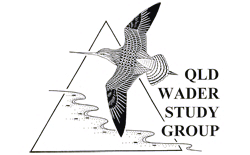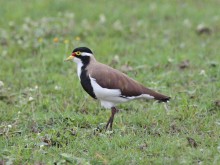Site information:
Laidley is situated about 90 km west of Brisbane and is in the heart of the fertile Lockyer Valley, an area renowned for its vegetable production. The valley contains several wetlands, which can provide a very rewarding bird watching experience. The water levels in the wetlands fluctuate depending on the season and this has a major bearing on the bird-life likely to be seen.
A short drive west of Laidley is Lake Dyer, a site where Painted Snipe has bred in recent years. In early 2002, both parents and five offspring were observed over a period of several weeks at the farm dam on the left hand side of the road just before the picnic area. Also likely to be seen feeding around the muddy edges of the lake are Marsh Sandpiper, Sharp-tailed Sandpiper, Black-winged Stilt, Black-fronted Dotterel and Red-kneed Dotterel. A variety of waterbirds are also normally present. The southwest end of the lake is a favourite haunt of Cotton Pygmy-goose.
Further west of Lake Dyer are Jahnke’s Lagoon and Lake Clarendon. After good rains, Jahnke’s Lagoon is a good place to see a variety of waterbirds and some waders such as Black-winged Stilt, Black-fronted Dotterel and Red-kneed Dotterel. Blue-billed Duck and Cotton Pygmy-goose have been recorded here. Another possibility is Black-necked Stork. Jahnke’s Lagoon is ephemeral and does completely evaporate in dry seasons. Lake Clarendon, an irrigation dam, is more permanent but does dry up completely on occasions. In addition to the previously mentioned species, Black-tailed Godwit, Red-necked Avocet, Marsh Sandpiper, Sharp-tailed Sandpiper, Banded Lapwing and Australian Pratincole can be found here. A lone Banded Stilt was seen here in the autumn and winter of 2002, a vagrant in south-east Queensland. Lake Clarendon is also a good site to find Musk Duck, Freckled Duck, Blue-billed Duck and Cotton Pygmy-goose. Don’t forget to glance skywards occasionally, as Black Falcon often frequent the area.
Probably the jewel in the crown of the Lockyer Valley is Seven Mile Lagoon at Lockyer Waters. Tens of thousands of water birds have been known to congregate at this site after good spring or early summer rain. Many a rarity has been twitched, including Little Curlew, Painted Snipe, Oriental Pratincole and Australian Pratincole. This was the case in December 1996 when Little Curlew and Oriental Pratincole were recorded simultaneously. Australian Pratincole was seen here in October 2001. Common species of wader are Latham’s Snipe, Black-tailed Godwit, Marsh Sandpiper, Sharp-tailed Sandpiper, Black-winged Stilt and Red-necked Avocet. Waterbirds seen here include ducks (including the occasional Freckled Duck), grebes, darter, cormorants, pelican, herons, egrets, ibis and spoonbills as well as Black-necked Stork. Beware that Seven Mile Lagoon is dry more often than not.
The next stop after Seven Mile Lagoon is Atkinson Dam. On the way to this site, remember to stop and inspect the turf farms along Banool and Watsons Roads, where Banded Lapwing have bred. Atkinson Dam is a popular fishing and water skiing spot when it is at or near full capacity. At these times, it is best to continue down the main road and access the dam from the Atkinson Dam Waterfront Caravan Park where powerboats are prohibited. The ideal time to visit Atkinson Dam is in a dry season when the water level is low and water skiing is not possible. This is when the birds have the area to themselves and Black-tailed Godwit, Little Curlew, Marsh Sandpiper, Sharp-tailed Sandpiper and occasionally Pectoral Sandpiper congregate in and around the remaining water. As with the other lakes in the region, thousands of waterbirds may be seen including ducks, grebes, darter, cormorants, pelican, herons, egrets, ibis and spoonbills.
How to get there: To adequately navigate around Lockyer Valley, a map is essential and the following instructions are only meant as a guide. One of the better maps is a tourist map entitled “The Lakes Around Brisbane”, published by Sunmap. Also recommended is the “Downs*Lockyer Roads and Streets Directory” (ISBN 0-9585171-1-8), which contains detailed maps of the valley.
Lake Dyer is best reached from Brisbane by following the Warrego Highway towards Toowoomba. About 45 km after the Ipswich bypass, take the Laidley exit at Plainland. Drive through Laidley and just after the township, a sign-posted road to the right leads to Lake Dyer, about 2 km away. Lake Clarendon is further west and can be reached by taking the Esk turnoff from the Warrego Highway (just before the township of Gatton) about 11 km from Plainland.
About 1 km after leaving the highway and crossing Lockyer Creek, turn right into Lake Clarendon Way, sign-posted to Lockyer Waters. Jahnke’s Lagoon is about 500 m on the left. A further 5 km along this road is Lake Clarendon. Take Main Greenswamp Road where it joins Lake Clarendon Way, just past the state school. The entrance to the picnic area is less than 500 m down the road.
To get to Seven Mile Lagoon from Lake Clarendon, return to Lake Clarendon Way and follow the signs to Lockyer Waters about 12 km further on. The lagoon can be seen from Jimba Road but a spotting scope is essential.
Lake Atkinson is about 7 km further on from Seven Mile Lagoon. From the Warrego Highway, take the turnoff at Minden and following the signs for a distance of about 24 km.
Site coordinates:
Lake Dyer Lat 27º 38’ 30” S, Long 152º 22’ 60” E
Jahnke’s Lagoon (Lat 27º 32’ 21” S, Long 152º 19’ 20” E
Lake Clarendon (Lat 27º 31’ 01” S, Long 152º 21’ 28” E
Seven Mile Lagoon (Lat 27º 27’ 20” S, Long 152º 25’ 10” E
Lake Atkinson (Lat 27º 25’ 24” S, Long 152º 26’ 58” E.
Amenities/access: Toilet and picnic facilities are available at Lake Dyer, Lake Clarendon and Lake Atkinson. Depending on the water level at these sites, it may be necessary to walk some distance to get good views of the birds and even then, use of a spotting scope is recommended. Seven Mile Lagoon lies within private property and is normally viewed from the side of the road.
Wader species: Latham’s Snipe, Black-tailed Godwit, Little Curlew, Marsh Sandpiper, Pectoral Sandpiper, Sharp-tailed Sandpiper, Painted Snipe, Comb-crested Jacana, Red-necked Avocet, Black-fronted Dotterel, Red-kneed Dotterel, Banded Lapwing, Masked Lapwing, Oriental Pratincole and Australian Pratincole.
Other species: Magpie Goose, Plumed Whistling-Duck, Wandering Whistling-Duck, Blue-billed Duck (rarely), Freckled Duck (rarely), Cotton Pygmy-goose, Australasian Shoveller, Pink-eared Duck, Hardhead, Australasian Grebe, Great-crested Grebe, White-necked Heron, Glossy Ibis, Royal Spoonbill, Yellow-billed Spoonbill, Black-necked Stork, Gull-billed Tern, Caspian Tern and Whiskered Tern.

